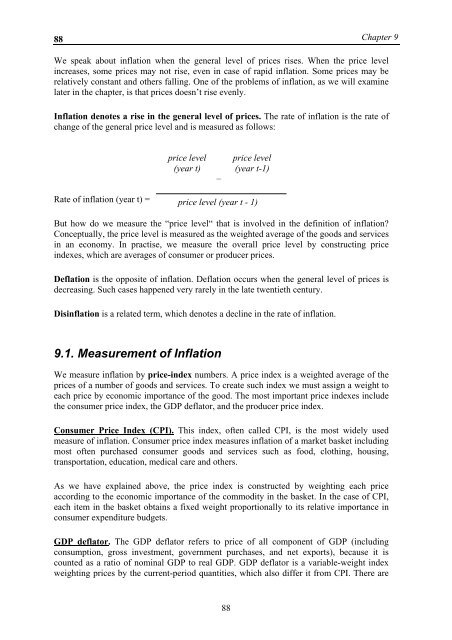MacroeconomicsI_working_version (1)
Create successful ePaper yourself
Turn your PDF publications into a flip-book with our unique Google optimized e-Paper software.
88<br />
Chapter 9<br />
We speak about inflation when the general level of prices rises. When the price level<br />
increases, some prices may not rise, even in case of rapid inflation. Some prices may be<br />
relatively constant and others falling. One of the problems of inflation, as we will examine<br />
later in the chapter, is that prices doesn’t rise evenly.<br />
Inflation denotes a rise in the general level of prices. The rate of inflation is the rate of<br />
change of the general price level and is measured as follows:<br />
price level<br />
(year t)<br />
–<br />
price level<br />
(year t-1)<br />
Rate of inflation (year t) =<br />
price level (year t - 1)<br />
But how do we measure the “price level“ that is involved in the definition of inflation?<br />
Conceptually, the price level is measured as the weighted average of the goods and services<br />
in an economy. In practise, we measure the overall price level by constructing price<br />
indexes, which are averages of consumer or producer prices.<br />
Deflation is the opposite of inflation. Deflation occurs when the general level of prices is<br />
decreasing. Such cases happened very rarely in the late twentieth century.<br />
Disinflation is a related term, which denotes a decline in the rate of inflation.<br />
9.1. Measurement of Inflation<br />
We measure inflation by price-index numbers. A price index is a weighted average of the<br />
prices of a number of goods and services. To create such index we must assign a weight to<br />
each price by economic importance of the good. The most important price indexes include<br />
the consumer price index, the GDP deflator, and the producer price index.<br />
Consumer Price Index (CPI). This index, often called CPI, is the most widely used<br />
measure of inflation. Consumer price index measures inflation of a market basket including<br />
most often purchased consumer goods and services such as food, clothing, housing,<br />
transportation, education, medical care and others.<br />
As we have explained above, the price index is constructed by weighting each price<br />
according to the economic importance of the commodity in the basket. In the case of CPI,<br />
each item in the basket obtains a fixed weight proportionally to its relative importance in<br />
consumer expenditure budgets.<br />
GDP deflator. The GDP deflator refers to price of all component of GDP (including<br />
consumption, gross investment, government purchases, and net exports), because it is<br />
counted as a ratio of nominal GDP to real GDP. GDP deflator is a variable-weight index<br />
weighting prices by the current-period quantities, which also differ it from CPI. There are<br />
88




